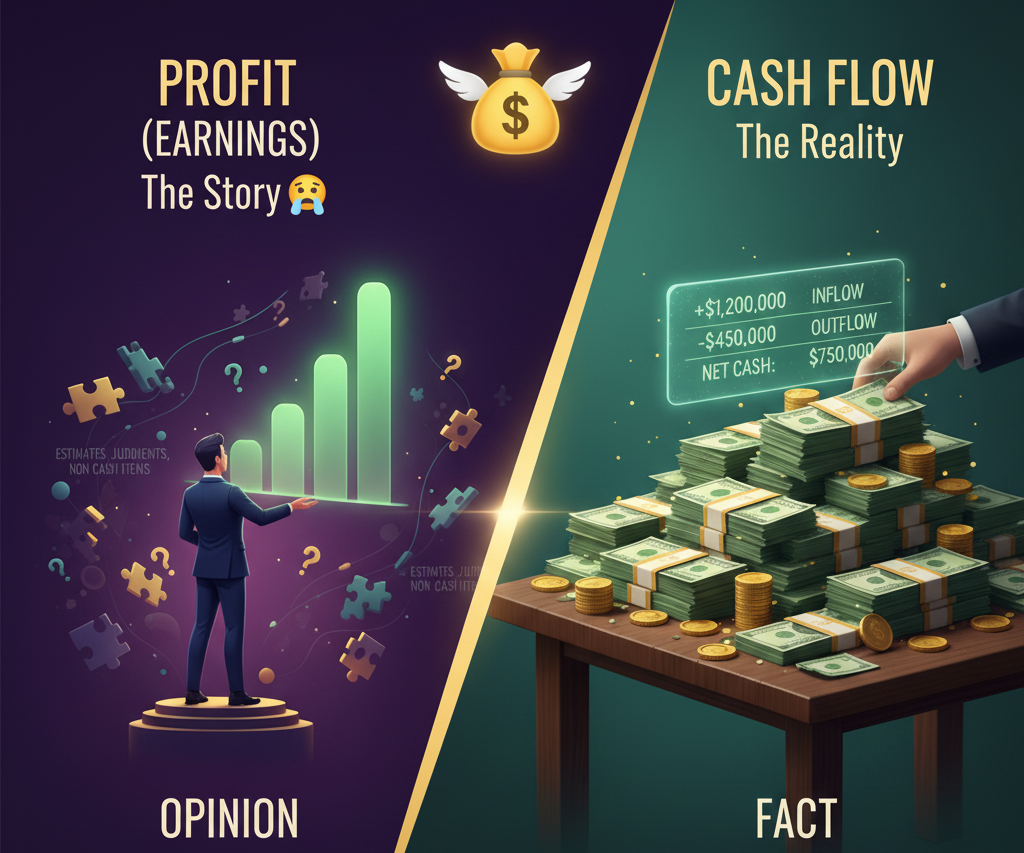Have you ever seen a company announce “record profits,” only to watch its stock price mysteriously tank a few months later? It feels confusing, even unfair. You thought you were investing in a winner, but it felt like a bait-and-switch.
The problem isn’t you. It’s that you were looking at the wrong number.
Most investors focus on profit, also known as net income or earnings. But smart investors, the ones who build lasting wealth, know the real story is hidden in a company’s cash flow. Understanding the difference is like having x-ray vision for your investments.
Profit vs. Cash: The Story vs. The Reality 🤑
Think of a company’s finances this way:
-
Profit (Earnings) is the company’s story. It’s like a report card graded by accountants. It includes all sorts of non-cash items, estimates, and judgments that can make the company look better (or worse) than it really is.
-
Cash Flow is the company’s bank account statement. It shows the actual, hard cash moving in and out. It’s the money used to pay bills, invest in new projects, and pay dividends to you. Cash doesn’t lie.
The biggest reason for the gap between these two? An accounting concept called depreciation.
Imagine you buy a brand-new $3,000 delivery van for your business. On paper, your accountant doesn’t say you lost $3,000 on day one. Instead, they “depreciate” it, maybe subtracting $600 from your profits each year for five years.
That $600 is an expense that makes your profit look smaller, but you didn’t actually spend $600 in cash this year. The real cash left your bank account when you first bought the van!
How This Looks in the Real World 🧐
This isn’t just theory. This gap between profit and cash can either hide a huge red flag or reveal a hidden gem.
-
The Hidden Gem 💎: Back in the day, a company like Macy’s reported a profit of just one penny per share. Scary, right? But when you looked at their cash flow, they had generated a whopping $1.41 per share in real cash! Their profits looked tiny because of large depreciation charges on old stores, but cash was piling up. This was a signal of hidden strength.
-
The Warning Sign 🚩: Now consider a railroad company like Union Pacific. They have to spend enormous amounts of real cash every year to maintain tracks and trains (this is called Capital Expenditure). In one year, they spent $3.64 per share in cash on these items but only reported $2.12 per share in depreciation. Their profits looked much healthier than their cash situation, which was being drained to keep the business running.
Your Simple “How-To” Strategy
You don’t need an accounting degree to use this secret. Next time you research a stock, just do this:
-
Find the Net Income (the profit).
-
Find the Cash Flow From Operations.
-
Compare them. Are they worlds apart? If so, ask why.
A company with profits that are consistently much higher than its cash flow might be heading for trouble. On the other hand, a company with ugly profits but gushing cash flow could be the bargain you’ve been looking for.
Always remember: profits can be shaped and molded, but at the end of the day, a business survives on cold, hard cash.
Have you ever been burned by a company that reported great profits but still failed? Share your story in the comments below!
Follow me for more simple, smart investing strategy.
Join the Relax to Rich Club, where we grow wealth the calm, thoughtful way. ✨

